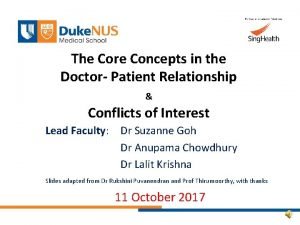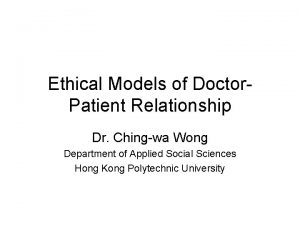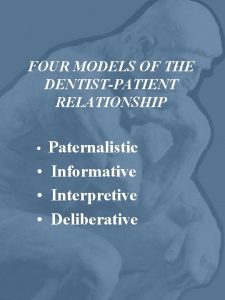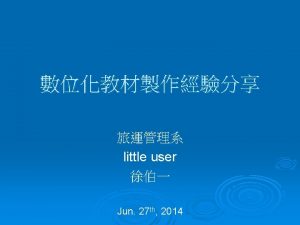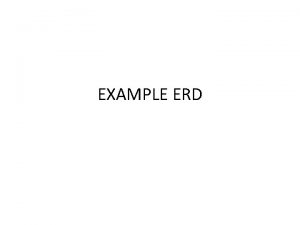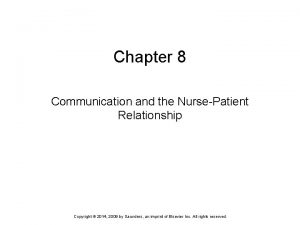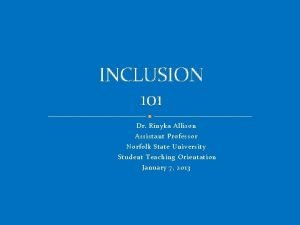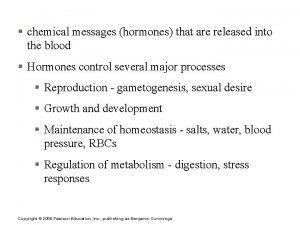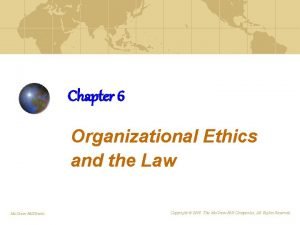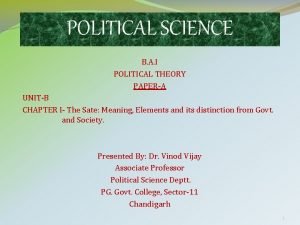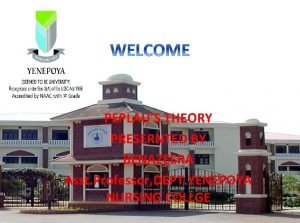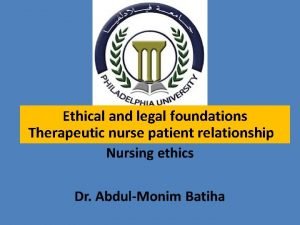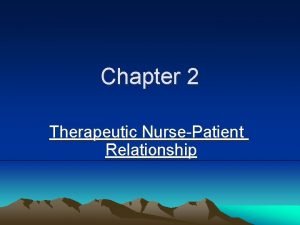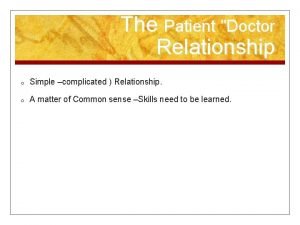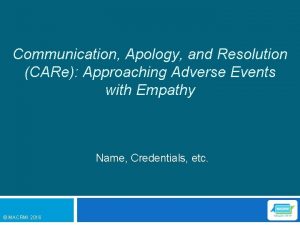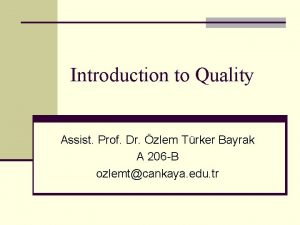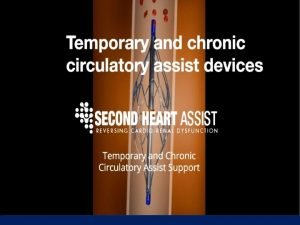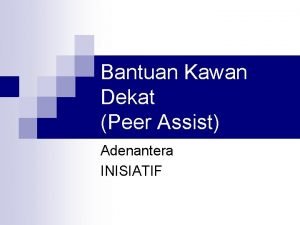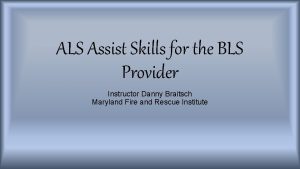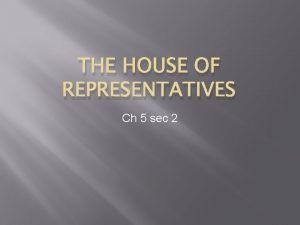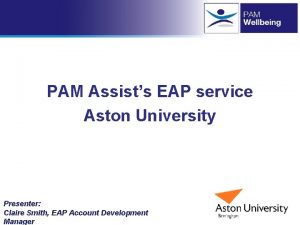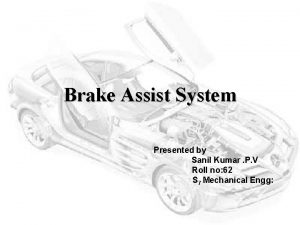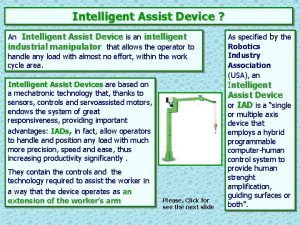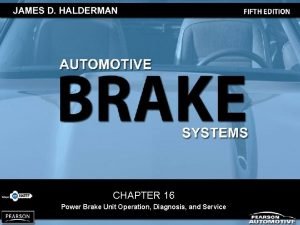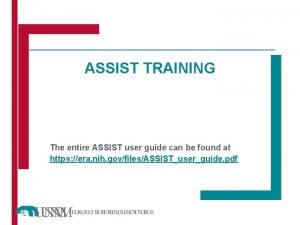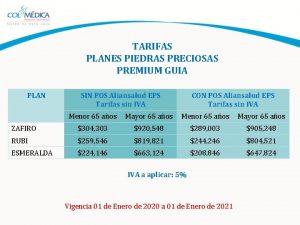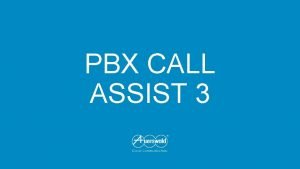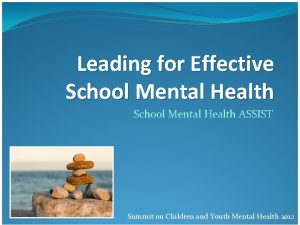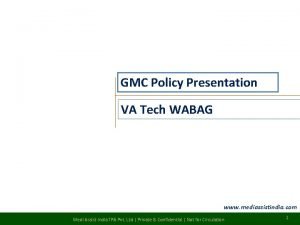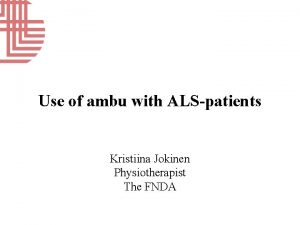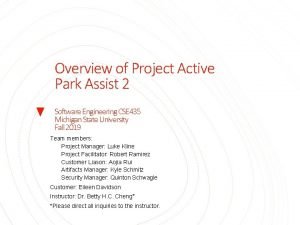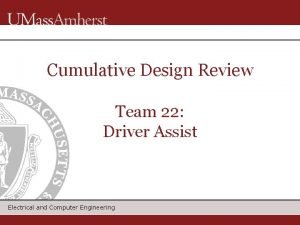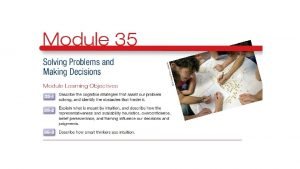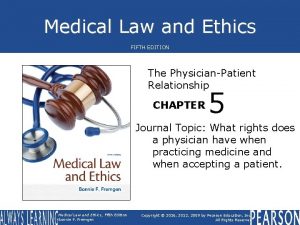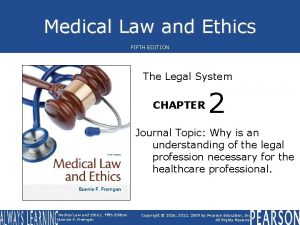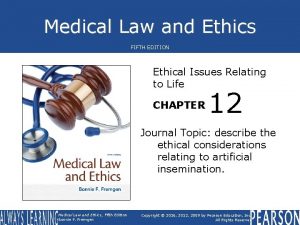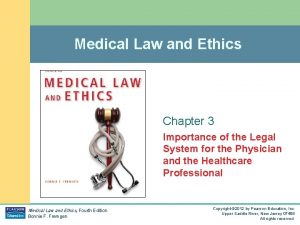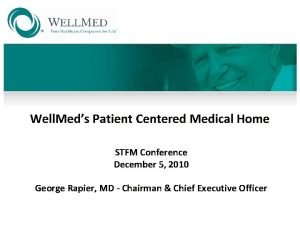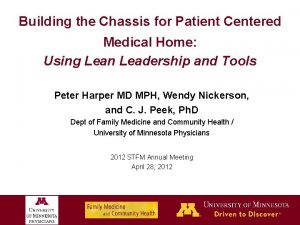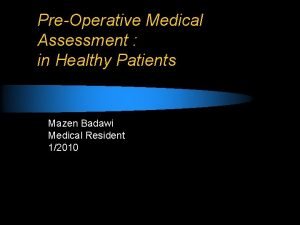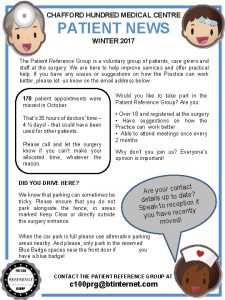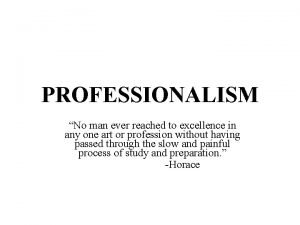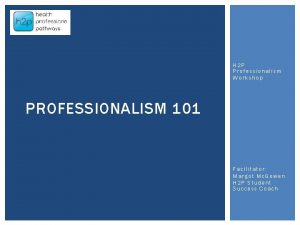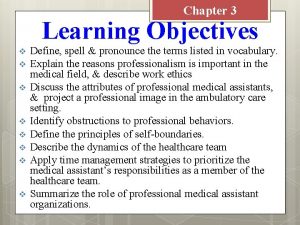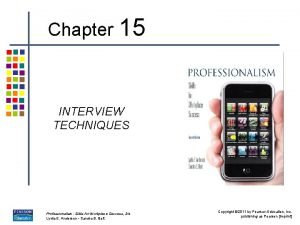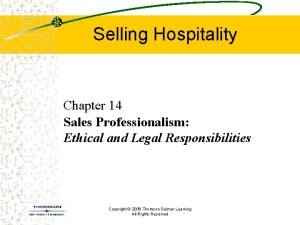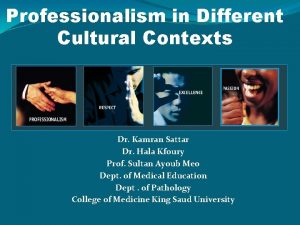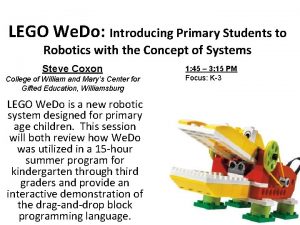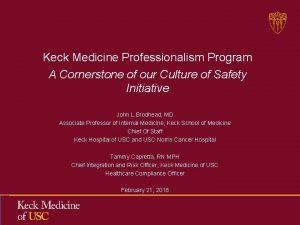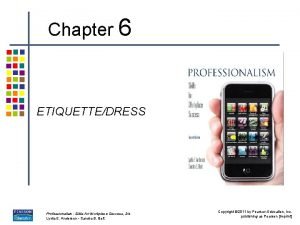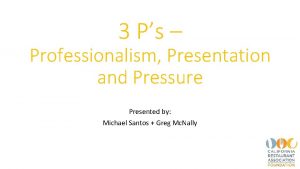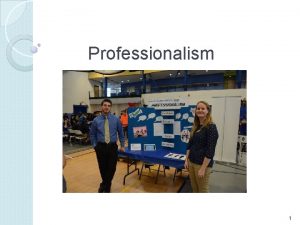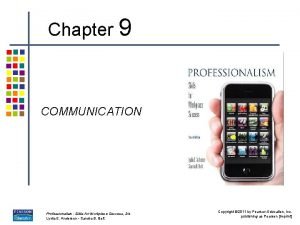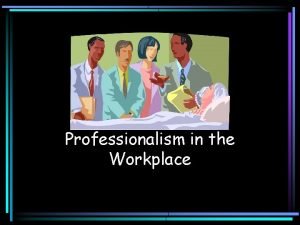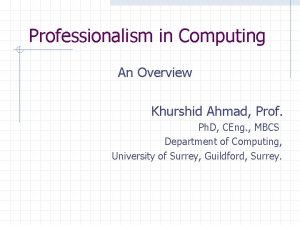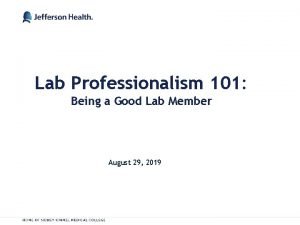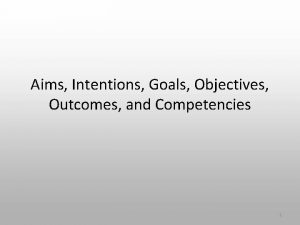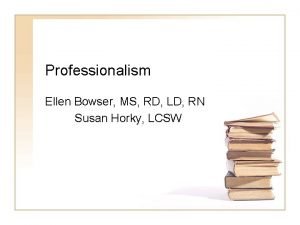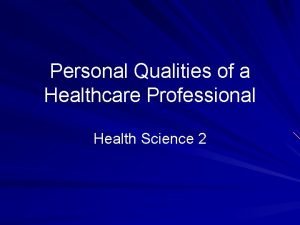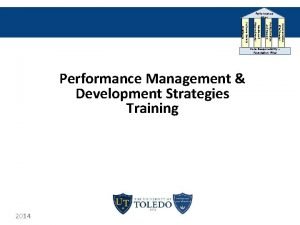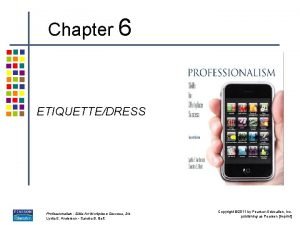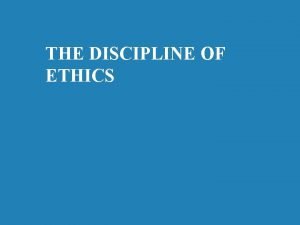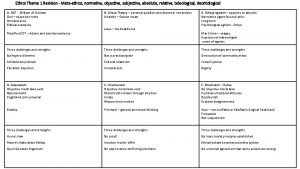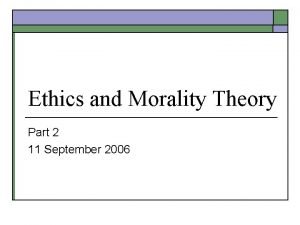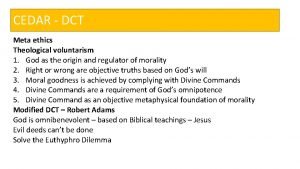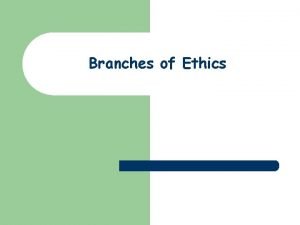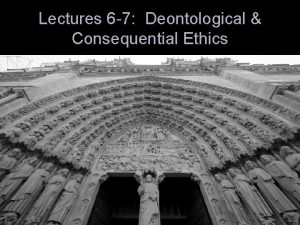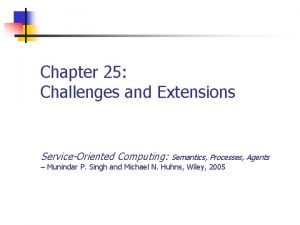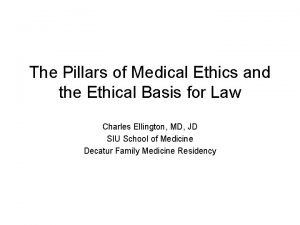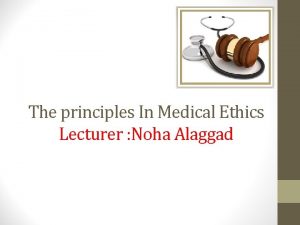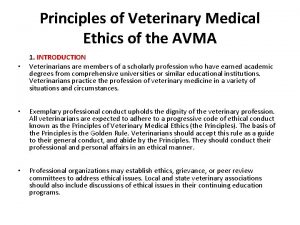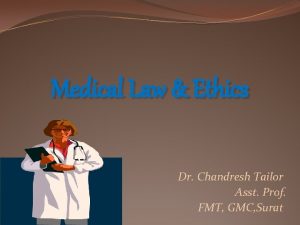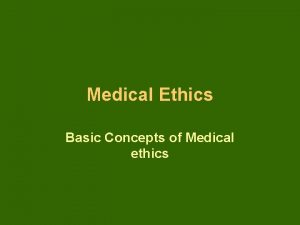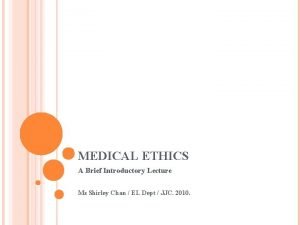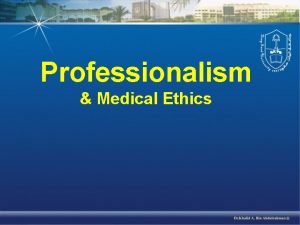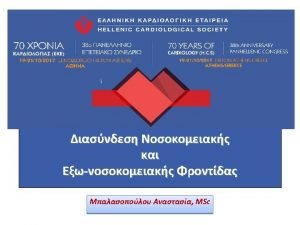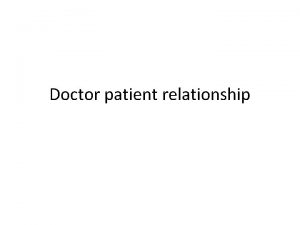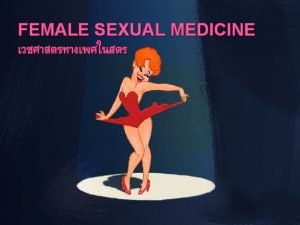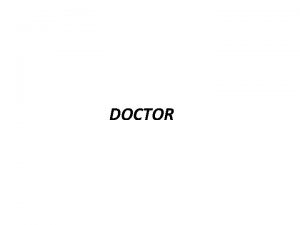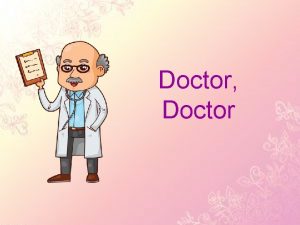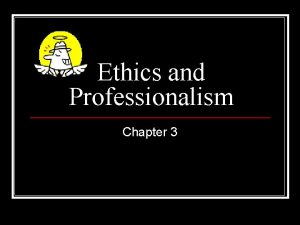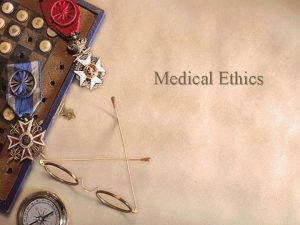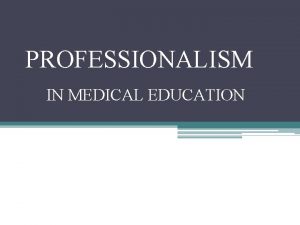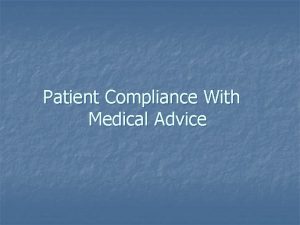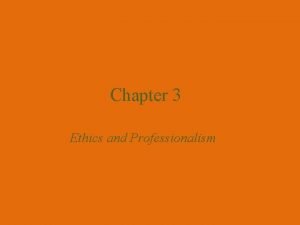MEDICAL ETHICS PROFESSIONALISM AND DOCTOR PATIENT RELATIONSHIP Assist












































































































- Slides: 108


MEDICAL ETHICS PROFESSIONALISM AND DOCTOR - PATIENT RELATIONSHIP Assist. Prof. Dr. Muhammad Nawz Virk MBBS, M. Sc, MPH Faculty of Allied Health Sciences The University of Lahore

1. Relevance of Ethics in the Life of a Doctor n This highlights the need to seek clear guidelines on how doctors are expected to behave and the parameters that they must follow to be considered 'ethical professionals'.

n The community puts the doctor at a very high pedestal. They are expected to be kind, caring, helping, committed to health, be just and equitable, dependable, keep the gains of their patients above their own, never harm anybody, show character and resilience, communicate effectively, compassionately and fearlessly.

n The behaviour of doctors is also called upon to reflect the traditions, customs, norms and values associated with them over centuries of history of their profession.

n A doctor also faces various dilemmas and difficult choices in his daily practice such as taking consent from patients and families with low literacy and inadequate understanding of health issues and procedures.

n n 2. Scope and Meaning of Medical Ethics Medical ethics is the study of moral aspects of a doctor's professional life. The two branches of ethics relevant to a medical professional are:

n Normative Ethics: concerned with the established norms of conduct, that provide theoretical framework and principles that can guide a doctor dealing with a practical problem e. g. whether he should take consent about surgery from an illiterate man, fearing that the patient may make a wrong choice (as was the case in the tea bar dialogue, when Dr Khalid chose to remove the appendix of Ahmed without his consent).

n Descriptive Ethics: concerned with the study and compilation of data on the actual moral behaviour and beliefs expected by the society as regards behaviour of doctors, medical issues and dilemmas e. g. should public money be used to treat patients of drug abuse and AIDS? Should the Population Control Division pay the bills of an employee seeking a test tube baby or in vitro fertilization (IVF)?

n Should Dr Khalid charge consultation fee from all patients irrespective of their paying capacity?

3. Four Pillars of Medical Ethics n n The classical pillars of medical ethics on which the life and practice of a health professional must build an example of normative ethics. They include autonomy, beneficence, nonmaleficence, and justice. a. Autonomy: implies that it is the patient who should ultimately choose the procedure(s) he or she may or may not want to undergo.

n b. Beneficence: calls for all medical professionals to do good for all patients under all circumstances, the same way as ordinary citizens are good to their parents and children alone. The doctors therefore have a special relationship with their patients demanding care and goodness from them as a duty and an obligation. (Javed's objection to Dr Khalid's choice of charging the poor was based on the norm of beneficence).

n c. Non- maleficence is the obligation of a doctor to do no harm, or to minimize it as much as possible, in his therapeutic interaction with his patients. It is an extension of the principle of beneficence and requires the doctor to protect his patient against all forms of harm and always act in his best interest, the same way a father acts in a paternalistic fashion with his offspring.

n (Dr Khalid's decision to protect Ahmed from the risks of an inflamed appendix by operating on him even without his consent was an expression of this same paternalism).

n d. Justice: means that health resources must always be distributed according to principles of justice keeping in mind the equal need as a measure of equity. The doctor has to be fair, equitable and impartial in his selection of deserving cases when it comes to making the choice in distribution of care or a resource or a treatment.

4. Common Ethical Omissions in Medical Practice n n a. Informed Consent and Confidentiality The two commonest ethical concerns for a physician are consent and confidentiality, yet they are the two paramount norms that are most often ignored by physicians.

What is Informed Consent? n Consent is the agreement of the patient to an examination, procedure, treatment or intervention. It can be given orally, by signing a form or a written statement or simply agreeing by a gesture e. g. offering to pull up the shirt for letting the doctor examine the abdomen. It must always be obtained in advance.

b. Medical Students and the Issues of Consent and Confidentiality: n n 5. Common Ethical Dilemmas in a Doctor's Life: A doctor on account of his unique position in the society has access to the most intimate corners of the lives of people.

n He is therefore likely to come across unusual social situations. The doctor is not expected to respond to these situations like other members of the society and a minor stumble on his part can sometimes be enough to compromise his position. Some of the common situations where he needs to show prudence and not take the obvious course or show a knee jerk response are discussed below.

n n a. Accepting gifts from patients: Sharing of gifts as an expression of gratitude is a common norm in nearly all societies. It is even more pronounced in ours and in certain subcultures the person who brings in the gift may feel offended and insulted if his offerings are not accepted.

n A clear set of guidelines should therefore be followed by health professionals which may eventually become a well known custom of the medical community in the society.

n The citizens would then gradually start to follow the set norms. A safe recommendation in this regard is to accept a parting gift at the end of a successful treatment, as long as it is in form of a bouquet of flowers, or a box.

n Extravagant and expensive gifts must never be accepted as it means that the patient is putting you under a heavy obligation or has elevated you to an extraordinary pedestal.

n Both scenarios can land the doctor into serious trouble in the long run. If a patient does so it is safe to return the gifts saying "I will not be able to accept this gift, as it is against my professional ethics.

n n b. Sexual boundaries violation: sexual relationships in medicals settings: Doctors operate in odd hours, in close and sometimes intimate settings for long hours and without clearly defined boundaries of age, gender, social class and physical attributes.

n They work with fellow, senior and junior colleagues, nurses, paramedics, patients and their families, visitors and associated professionals from departments of sociology, social work, psychology, NGOs, pharmaceutical industry, and many related organizations.

n All forms of liaisons and relationships involving personal intimacy of sexual nature in the hospital settings is considered unethical and illegal.

n n This is to protect the sanctity of the medical profession and the hospital. A sexual liaison between a patient and his or her doctor is prohibited by law and the regulations governing the profession, the world over. At a psychological level such a relationship is considered at par with incest. The same rule applies to a medical student working with a patient.

c. Charges and Fee: Patients, Colleagues, Teachers, Medical Students n While it is not unethical to charge a fee for a consultation, procedure or an intervention, it is against the customs and norms to base the doctor patient relationship on their capacity to pay.

n The charges should also be never flamboyant, or vary from one set for the poor and another for the rich. A simple ethical rule is to determine a fee structure that does not render a doctor, a procedure or an intervention, beyond the reach of an ordinary and an average citizen. Traditionally, doctors are not expected to charge from their colleagues, teachers, medical students or paupers.

d. E-Consultations and Telemedicine n Since the last couple of years since the first edition of this book, e consultations and telemedicine has become a reality. Telemedicine is linking up far flung areas and cities like Gilgit and Skardu are being linked with Islamabad.

n The phenomena of telemedicine is being practiced without boundaries around the world and with the advent of 'Skype' and video links, it is likely to progress even further.

n In fact surgical interventions are being monitored by the experts in the field from a distance through video links especially in the war arena.

n While the appearance of doctors on television channels to enhance health literacy and promote the preventive aspects of illness and rehab measures is flourishing, any attempts at diagnosing and treating patients during these interactions are not considered as ethically correct.

e. Media and Medicine n The last two decades have witnessed a rapid growth of the print and electronic media.

n This has resulted in our excessive dependence on the media for all kinds of information. Whether its the latest development in politics or the day's weather, the addictive nature of media technology keeps most people glued to their TV or computer screens for considerable lengths of time each day.

n The news media are also an important source of information on health and medical therapies

n n f. Euthanasia and physician assisted suicide Euthanasia or physician assisted suicide can be considered one of the most prevalent problems when dealing with the ethics of patient treatment. A world wide debate still continues on this subject. Should people have the right to end their own lives when prolonging it will only cause them more pain?

n Should families who love someone so much, that they don't want to lose them, cause them more pain by keeping them alive.

n From the Greek term for good death, euthanasia means compassionately allowing, hastening or causing the death of another. Generally someone resorts to euthanasia to relieve suffering, maintain dignity and shorten the course of dying when death becomes inevitable.

n Euthanasia can be voluntary if the patient has requested it or involuntary if the decision is made without the patient's consent. Euthanasia can be passive simply withholding heroic life saving measures or active deliberately taking a person's life. Euthanasia assumes that the intent of the physician is to aid and abet the patient's wish to die.

g- Relationship with pharmaceutical industry n The doctors and the pharmaceutical industry need to have a congenial, and a professional relationship aimed at mutual pooling of resources to promote welfare of health institutions and patients and to invest in research.

n n The use of this relationship for personal gains or profiteering is, however, unethical. The relationship of a doctor with the pharmaceutical industry walks on a very tight rope.

n If used prudently it can enhance the image of the medical profession and bring great advantages for research and welfare of patients. A minor slip on the part of the doctor or an overenthusiastic nonprofessional interaction on the other hand can cause him great harm.

n The single agenda that should drive a doctor in his prescription drugs has to be the benefit and cure of his patient's ill health. The doctor under all circumstances must prescribe those drugs that are most cost effective, the most efficacious and those supported by most evidence base.

6. Rights and Responsibilities of Patients n It is useful to have a list of rights that medical ethics grant to a patient. The doctor has a duty to display, propagate, communicate and assist patients in protecting these rights. The patients have the right to:

n • Informed consent about the condition, problem or disease, the treatment or procedure to be followed, including details of alternative procedures, and all the risks or side effects involved, the costs of any procedure proposed, any further costs associated with rehabilitation, the health care system, and details of support services.

n n Withdraw consent at any time. Refuse experimental or research treatment. Obtain a second opinion. Have details of a condition and treatment kept confidential by medical and hospital staff.

n Leave a hospital at any time (except in the cases of infectious disease or certain psychiatric conditions). If the patient leaves without the hospital's consent, however, he is liable for any injury or illness caused, or aggravated by, the action.

n n n Be treated with care, consideration and dignity. Request medical files from the doctor. Obtain legal advice regarding any matter arising from the treatment.

n n n Contact friends, relatives, solicitors, members of the religious/faith group or his or her wards if he or she is the parent or guardian. Ask to stay with a child at all times except where separation is necessary for medical reasons. Inform nursing staff if he or she wants to or does not want to see, or speak to a visitor or caller.

Responsibilities of Patients n n n The Alongside the rights, patients have a responsibility to: Know their own medical history including medications taken Keep appointments or advise / inform those concerned if they are unable to do so.

n n Comply with the treatment advised / supplied. Inform the doctor if they are receiving treatment from another health professional Know how their charges of treatment are best covered. Conduct themselves in a manner which will not interfere with the well being or rights of other patients or staff.

7. Doctor-Patient Relationship: n The basis of the unique relationship between a doctor and the patient is the capacity of the doctor to appreciate the complexity of human behaviour, his ability to empathise, his skills of active listening, effective verbal and non verbal communication and his sensitivity towards the effects of history, culture, and environment, as well as psychological and biological factors on his patients.

n n The bond that forms in the relationship can take three forms: The vertical model, where the doctor completely takes over the process of care with the patient having virtually no role e. g. when a patient is unconscious, immobilized or in an altered state of conscious, or is incapacitated.

n The teacher student model, where the doctor plays a role similar to that of an authority figure (such as a teacher or a parent), who dominates, controls and guides the patient e. g. a patient who is recovering from a surgical intervention.

n The mutual participation, horizontal model, where the doctor and the participation behave as partners in the process of healing and care.

n n The major dangers in this relationship include: The doctor assuming the role of a savior and fantasizing that only he or she can rescue the patient from all the troubles of the world

n n The doctor's inability to switch off and or leave behind the distresses and problems of the patients when away from the clinical setting. A need to control everything in the life of the patient and to try and prevent death, which may not be possible in all cases.

n A doctor visualising his or her own troubles, complexes and difficulties in the patients e. g. a doctor having a disturbed relationship with his father, assuming that the patient must also be going through such difficulties or a doctor avoiding to discuss such an issue with his or her patient even when it is of clinical significance.

n • The doctor may start to pass value judgments or become judgmental in his relationship with the patient and start to determine what he or she ought and ought not to do.

n • An enthusiastic medical student handing over financial and material help or seeking the same. Both the transactions are against the norms of professionalism.

a. Psychological Reactions in Doctor. Patient n n i. Transference: Here the feelings, attitudes, desires, and wishes originally linked with an important or a significant figure in a patient's early life (particularly childhood) e. g. the father, or mother, are invested (or projected) onto the doctor (as in the case of Mr Y, who was seen as a kind and compassionate replacement of the dead father of Miss X).

n If an adult patient in a medical ward starts to insist to be examined by one particular doctor, feels that the same doctor comes to his bed first and wants to spend longer time in the company of the same doctor, it may be on account of a paternal transference.

n The doctor, on account of his physical appearance, mannerism, or personality qualities, may remind the patient of his or her father. The feelings for the father that he felt as a child and were long forgotten, often come to the surface during admission in a ward.

n This often happens as the patients in a ward feel dependent and cared for, the same as children. This behaviour amongst grown up patients of reverting to behaviour as if they were a child is called regression. In this state they start to feel a strong bond for the doctor, similar to what they once had with a parent figure as a child.

n Depending upon the quality of the relationship with the person in childhood, the feelings for the doctor can be positive, or negative. When a patient is seen showing uncalled for anger, hostility or aggression towards a doctor, with no obvious cause in the present, an ignorant doctor, who is unaware of the phenomena of transference, may find it threatening and offensive.

n It may easily be merely an expression of negative transference. Similarly, positive transference feelings amongst patients commonly occur on long stay wards for the female nurses attending them, who remind them of a caring mother or an elder sister.

n The patients in such a state may openly express their desire to bond themselves with the nurse or a doctor as a sister, brother, mother, father, uncle or aunt.

n An unresolved and unaddressed transference can lead to prolongation of the patients stay in the ward, patients asking for personal phone numbers and home addresses of the carer and invitations to meet the doctor or the nurse to meet outside the clinical settings (as in the case of Mr Y and Miss X).

n The consequent ethical dilemmas that may follow call for a constant awareness and understanding of the phenomena of transference.

ii. Counter-transference: n Here the emotional responses of the doctor in form of his or her own needs, desires, and feelings, are directed towards the patient.

n The patient in such situations reminds the doctor of a well loved or detested or hated individual from the past, or fulfils an unfulfilled psychological need (as in the case of Mr Y who had a deep seated desire to feel a saviour and a rescuer, fulfilled by Miss X's reactions and statements

iii. Resistance n Some patients may be seen constantly defying prohibitions by the doctors in spite of repeated warnings of the serious consequences.

n The case of a patient of coronary artery disease who in spite of regular advice from his doctor, refuses to give up smoking, eats red meat regularly, finds the evening walks "boring" and makes no attempt to shed weight is exhibiting resistance in the doctor patient relationship. This is a result of a use of unhealthy defence mechanisms such as denial, avoidance, rationalization and suppression (discussed in detail in section E).

n The patient is often unaware of these phenomena and it may be useful to discuss them in a therapeutic interaction to make the patient conscious of the basis of his faulty behaviour.

n Resistance can seriously disrupt the doctor patient relationship; as a doctor who is unaware of it may gradually start to withdraw from the care of such a patient or refuse to treat him at all, resulting in obvious complications.


n Resistance may also appear as a transitory stage in the treatment process, gradually receding on its own or with a couple of sessions addressing the issue in a meaningful discussion with the patient. Clinically, resistance may present as non compliance or non adherence to treatment on part of the patient.

n When a patient is repeatedly seen to do so, it is important to consider it a psychological reaction in the doctor patient relationship that needs a deeper insight and understanding.

8. Professionalism in Health Care n A healthy doctor patient relationship is dependent on the professional standards and excellence of a doctor. This in turn is based on the knowledge, skills and attitude of the physician, who is expected to treat both the 'psyche' and the 'soma'. The following attributes of knowledge, skills and attitude are essential for any doctor, to be considered a professional.

Knowledge n n a. Distinguish Normality from Abnormality in the light of not only medical terms but also from a social and psychological perspective b. Relate biological factors with psychosocial factors in health and disease

Knowledge n n c. Use principles of behavioural sciences in clinical interviews, assessments and management plans d. Request and justify not only laboratory, radiological, and electrophysiological investigations but also make social and psychological inquiries

Knowledge n n e. Use pharmacological as well as non pharmacological interventions. f. Apply evidence base to clinical situations

Skills n n n Written Communication Skills a. Write comprehensive history of the patient b. Update medical records in clear, concise and accurate manner c. Write management plans, discharge summaries and referral notes d. Demonstrate competence in medical writing

Verbal Communication Skills n a. Establish professional relationships with patients and their relatives or caregivers in order to obtain a history, conduct a physical examination and provide appropriate management

Verbal Communication Skills n n n b. Demonstrate usage of appropriate language in e communication, seminars, bedside sessions, out patients and other work situations c. Demonstrate the ability to communicate clearly, considerately and sensitively with patients, relatives, other health professionals and the public

Verbal Communication Skills n n n d. Demonstrate competence in presentation skills e. Provide informational care and counsel patients f. Use principles of effective communication

(Section-A) in all his clinical interactions n n Patient Management Skills a. Interpret and integrate the history and examination findings and arrive at an appropriate differential diagnosis and final diagnosis.

n b. Demonstrate competence in problem identification, analysis and management of the problem at hand by the use of appropriate resources, and interpretation of investigation results.

n n n c. Prioritise clinical problems for the start of interventions d. Use evidence based pharmacological and psychosocial interventions e. Independently undertake counselling and informational care sessions


Skills in Research n n n a. Undertake literature search and collect evidence based medicine and standard guidelines for use in clinical practice. b. Interpret and use results of only peer reviewed and standard articles to improve clinical practice and not rely on data published by groups with a vested interest

Skills in Research n n c. Organize educational, training and research activities d. Actively participate in training and research activities

Attitudes Towards Patients n n a. Establish a therapeutic and ethical relationship with all patients. b. Demonstrate commitment to the bio psychosocial model in the assessment and management of the patients.

Attitudes Towards Patients n n c. Demonstrate sensitivity, empathy and understanding while performing physical and mental state examination. d. Consistently show consideration of the interests of the patient and the community paramount and always above personal interest

Attitudes Towards Patients n n n e. Adhere to principles of medical ethics under all circumstances f. Exhibit highest standards of professionalism through the practice of integrity, respect for patients, colleagues, seniors and juniors, compassion, honour, altruism, excellence and humanism g Demonstrate ability to work as a team member as well as a leader

Towards Self Development n n n a. Demonstrate consistent respect for every human being irrespective of ethnic background, culture, socio economic status and religion. b. Deal with patients in a non discriminatory and prejudice free manner. c. Deal with patients with honesty, equity and compassion.

n n d. Demonstrate flexibility and willingness to adjust appropriately to changing circumstances. e. Foster the habit and principles of self education and reflection in order to constantly update and refresh knowledge and skills and as a commitment to continuing education.

n n n f. Recognize stress in self and others. g. Deal with stress and support medical colleagues and allied health workers. h. Handle self criticism or criticism by colleagues or patients constructively.

n n i. Obtain and value a second opinion on clinical matters. j. Demonstrate effectiveness as member of the team, as well as a leader

Towards Society n n n a. Exhibit sensitivity towards the social, ethical and legal aspects of health care provision b. Offer cost effective professional services In addition to the above attitudes he/she must demonstrate a commitment towards following measures of PROFESSIONAL

Towards Society n CHARACTER DEVELOPMENT These measures can be used by the trainers of medical students and post graduate trainees to measure professionalism for

n n n n Professional attire Respect for time and punctuality Grasp and knowledge about patients under care Conscientiousness Integrity in reporting patients' findings Availability to the patients Relationships

Assessment of Attitudes (Professionalism) in Doctors n n n Professional attire/ demeanour Respect for time and punctuality Grasp and knowledge of own patients Conscientiousness

Assessment of Attitudes (Professionalism) in Doctors n n n Integrity in reporting patients findings Availability to the patients Relationships with colleagues, hospital staff and patients

n n n Score =1 10, 1 = Poor 2 4 = Not desirable 5 6 = Average: needs improvement 7 8 = Good 9 10= Exemplary: can serve as a role model

 Doctor-patient relationship ethics
Doctor-patient relationship ethics Dr patient relationship ethics
Dr patient relationship ethics Informative model
Informative model Doctor who google drive
Doctor who google drive Uml notation erd
Uml notation erd Patient 2 patient
Patient 2 patient Chapter 8 communication and the nurse patient relationship
Chapter 8 communication and the nurse patient relationship One teach, one assist pros and cons
One teach, one assist pros and cons Hormonal stimulus
Hormonal stimulus Ac 61-98 plan of action
Ac 61-98 plan of action The principles of professionalism
The principles of professionalism Integrity and professionalism
Integrity and professionalism Macro ethics definition
Macro ethics definition Relationship between law and ethics
Relationship between law and ethics What is ethics
What is ethics Relationship between law and ethics
Relationship between law and ethics Unitarian view of ethics
Unitarian view of ethics Political science and psychology
Political science and psychology Phases of nurse patient relationship
Phases of nurse patient relationship Nurse-patient relationship phases
Nurse-patient relationship phases What is hildegard peplau nursing theory
What is hildegard peplau nursing theory Phases of nurse patient relationship
Phases of nurse patient relationship Relationship to patient 書き方
Relationship to patient 書き方 Patient provider relationship
Patient provider relationship Patient provider relationship
Patient provider relationship Redcap choa
Redcap choa Leaders encourage mentoring to assist junior marines with
Leaders encourage mentoring to assist junior marines with Quality assist
Quality assist Second heart assist
Second heart assist Cisco smart assist
Cisco smart assist Peer assist adalah
Peer assist adalah Als assist
Als assist The whips assist the party leaders by
The whips assist the party leaders by Aig travel assist
Aig travel assist Pam assist
Pam assist Conclusion of brake system
Conclusion of brake system Intelligent assist device
Intelligent assist device A defective vacuum brake booster will cause a ________.
A defective vacuum brake booster will cause a ________. Assist user guide
Assist user guide Esmeralda guia premium
Esmeralda guia premium Pbx call assist 2
Pbx call assist 2 School mental health assist
School mental health assist Medi assist escalation matrix
Medi assist escalation matrix Military formations
Military formations Cisco smart assist
Cisco smart assist Kristiina jokinen
Kristiina jokinen Gx assist side effects
Gx assist side effects Active park assist 2
Active park assist 2 Mission assist
Mission assist Info assist
Info assist Assist electrical
Assist electrical What cognitive strategies assist our problem solving
What cognitive strategies assist our problem solving Emancipated minors definition
Emancipated minors definition Medical law and ethics 5th edition
Medical law and ethics 5th edition Medical law and ethics 5th edition
Medical law and ethics 5th edition Importance of medical law
Importance of medical law Patient centered medical home conference
Patient centered medical home conference Patient centered medical home
Patient centered medical home Preoperative medical evaluation of the healthy patient
Preoperative medical evaluation of the healthy patient Doctors heaton moor
Doctors heaton moor Assarts farm medical centre
Assarts farm medical centre No professionalism
No professionalism Domain 4 examples
Domain 4 examples Professionalism workshop
Professionalism workshop 3 key elements of professionalism
3 key elements of professionalism Summarize three obstructions to professionalism
Summarize three obstructions to professionalism Professionalism skills for workplace success
Professionalism skills for workplace success Attributes of professionalism
Attributes of professionalism Professionalism conclusion
Professionalism conclusion Sales professionalism
Sales professionalism What is professionalism
What is professionalism Professionalism in project management
Professionalism in project management Professionalism conclusion
Professionalism conclusion Professionalism conclusion
Professionalism conclusion Gracious professionalism definition
Gracious professionalism definition Vanderbilt professionalism program
Vanderbilt professionalism program Professionalism: skills for workplace success
Professionalism: skills for workplace success What are the three p's of professionalism
What are the three p's of professionalism Professionalism objectives
Professionalism objectives Professionalism skills for workplace success
Professionalism skills for workplace success Professionalism is judged against a set of
Professionalism is judged against a set of Professionalism in computing
Professionalism in computing Professionalism 101
Professionalism 101 Professionalism in a sentence
Professionalism in a sentence Professional development for teachers
Professional development for teachers What is professionalism
What is professionalism Professionalism examples
Professionalism examples Four pillars of service excellence
Four pillars of service excellence Gracious professionalism definition
Gracious professionalism definition Professionalism
Professionalism Professionalism skills for workplace success
Professionalism skills for workplace success Descriptive ethics vs normative ethics
Descriptive ethics vs normative ethics Briefly recap
Briefly recap Factual inquiry in ethics
Factual inquiry in ethics Metaethics vs normative ethics
Metaethics vs normative ethics Descriptive ethics vs normative ethics
Descriptive ethics vs normative ethics Beneficence
Beneficence Meta ethics vs normative ethics
Meta ethics vs normative ethics Branches of metaethics
Branches of metaethics Deontological ethics meaning
Deontological ethics meaning Teleological ethics vs deontological ethics
Teleological ethics vs deontological ethics Difference between medical report and medical certificate
Difference between medical report and medical certificate Difference between rm and crm
Difference between rm and crm 4 pillars of medical ethics
4 pillars of medical ethics What is medical ethics
What is medical ethics Avma principles of veterinary medical ethics
Avma principles of veterinary medical ethics Warning notice in medical ethics
Warning notice in medical ethics Confidentiality in medical ethics
Confidentiality in medical ethics Medical ethics lecture
Medical ethics lecture
